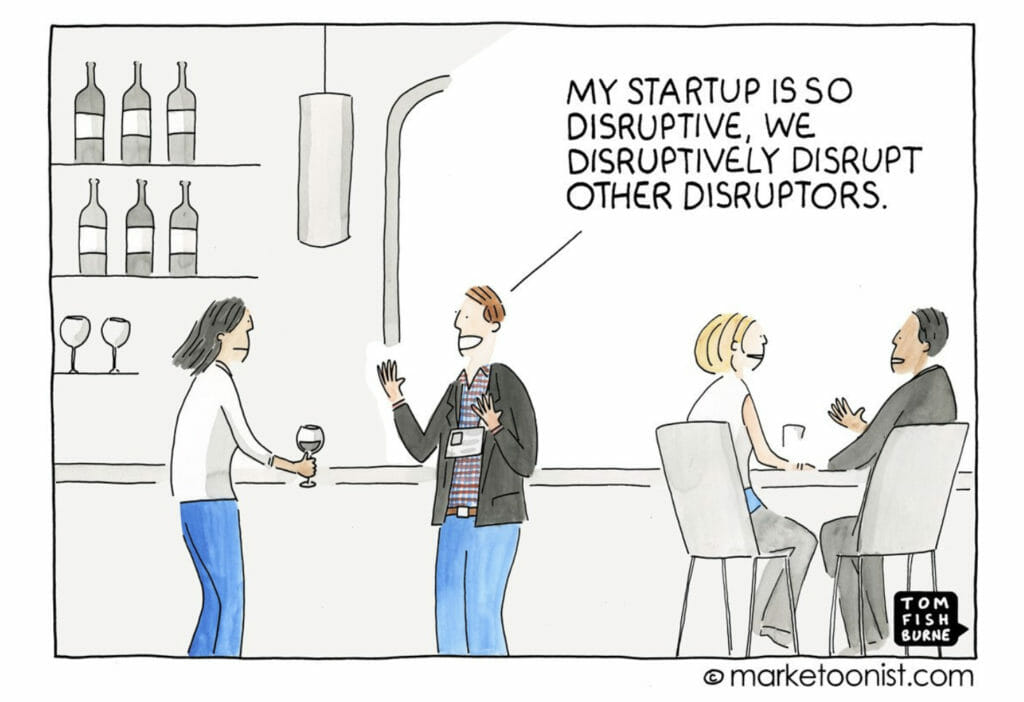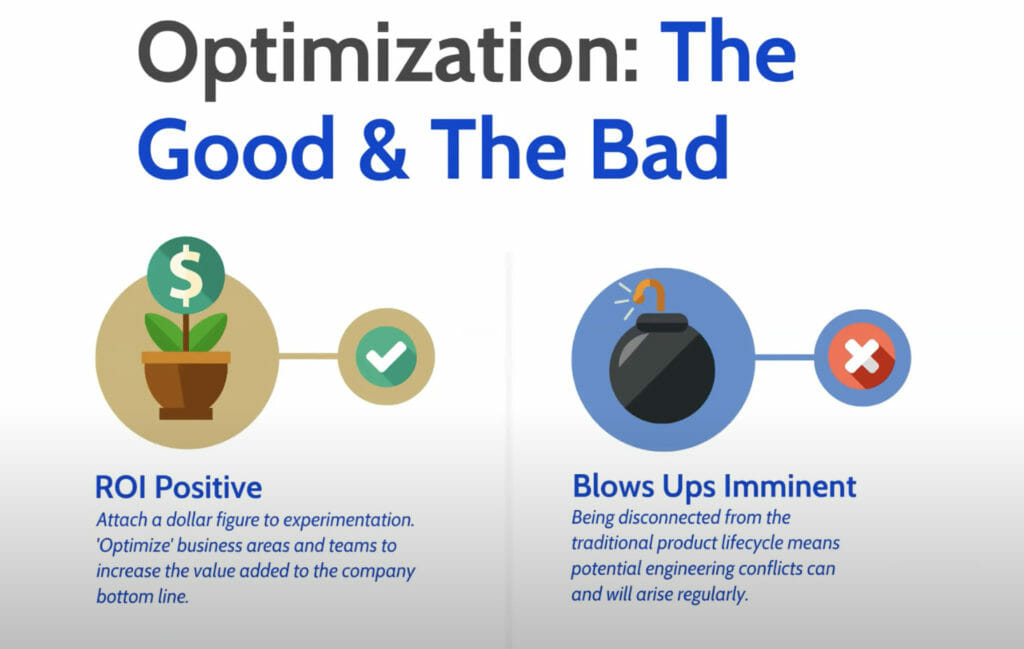Product Innovation: How To Build Products Your Customers Love

How do you go from good to great? How do you remain relevant as your competition continues to gain more market share? As the technology and business landscape continues to shift rapidly, companies that embrace innovation will have a clear advantage over those who don’t.
As with most things in marketing and business, product innovation isn’t something that happens from a few meetings or putting together a polished slide deck. From who you hire to holding your team accountable for certain OKRs, innovation requires buy-in from your entire organization.
In this article, I’ll share what product innovation is, why it matters, and how to build a company culture where innovation is the standard.
What is product innovation?
When you hear the word innovation, what immediately comes to mind?
Do you think of companies like Amazon and Google? Does product innovation refer to creating entirely new products or improving previous offerings?
At the most basic level, product innovation is the process of developing and marketing a new or improved product to solve your customer’s problems.
In The Innovation Delusion: How Our Obsession with the New Has Disrupted the Work That Matters Most, authors Lee Vinsel and Andrew L. Russel have a more direct take:
“Innovation, at its core, is change that can be measured because it generates profits.”
No matter how great your product or service is now, innovation is critical for continuing to serve your customers based on their current needs and desires and avoiding becoming an afterthought.
The challenges of innovation
To be innovative, you have to experiment. If you want to have more inventions, you need to do more experiments per week, per month, per year, per decade. It’s that simple. You cannot invent without experimenting, and here’s the other thing about experiments, lots of them fail. If you know it’s gonna work in advance; it is not an experiment.
– Jeff Bezos
Despite most businesses understanding the importance of innovation, it remains challenging to do. According to a McKinsey Global Innovation Survey, “although 84% of executives agree that innovation is important to growth strategy, only 6% are satisfied with innovation performance.”
In another study, “only one-third of U.K. business leaders said they were innovating successfully enough to generate revenue or measurable growth; only a quarter of boards of directors make innovation a priority, and 40% of leaders reject disruptive ideas because of a fear of failure.”
Many organizations claim innovation is a priority, but their high-level strategy and day-to-day operations say otherwise. For larger organizations especially, getting buy-in for innovation initiatives can be tricky.
And yet, you can’t expect to create a culture of experimentation if your employees are too afraid to speak up and share their ideas. You can’t build a culture of innovation if failure is treated as something to be ashamed about.
Innovation, by its very nature, carries risk. That said, in my many years of experience working with companies all over the world, the cost of not innovating comes at a hefty price.
Here are some of my key takeaways on how to build a culture of innovation as well as build products and services your customers love.
1. Avoid catastrophic failure
When it comes to innovation, knowing what not to do is just as important as knowing what to get right. One of the biggest mistakes I’ve seen companies make in their quest for innovation is not taking into account the worst-case scenario.
The upside of innovation can be a game-changer for your business, but not at the risk of damaging your brand permanently.
As I shared in my talk Test & Learn Community, author Nassim Taleb argues that it’s just as important to guard against catastrophic events (black swans) than it is to make incremental improvements.
Just as buying insurance can never generate ROI, validation experiments will not result in more money directly but does provide a safety net against business catastrophe.
While there are many examples of product innovation gone wrong, Netflix’s decision to spin off into another company called Qwikster nearly a decade ago continues to be talked about in many business circles today.
It turns out, two companies, two logins, and two billing accounts were something their customers did not want or need.
As CEO Reed Hastings noted at the time:
It is clear that for many of our members, two websites would make things more difficult, so we are going to keep Netflix as one place to go for streaming and DVDs… This means no change: one website, one account, one password… in other words, no Qwikster.
Another example I’ve discussed in the past, is the redesign Snapchat rolled out a few years ago.
Here’s what TechCrunch had to say at the time:
Snapchat’s redesign was a disaster. It cratered ad views and revenue and led Snapchat’s user count to actually shrink in March. That’s why CEO Evan Spiegel just announced a big reversal of the redesign’s worst part.
While both Netflix and Snapchat were able to avoid true disaster (at the cost of millions of dollars and lousy PR) for startups and smaller companies, a wrong move could lead to a situation that puts them out of business.
That isn’t to say, innovation is not worth the risk, but avoid experiments that may lead to irreparable harm.
2. Have a clear goal for innovation in mind
While virtually everyone business can benefit from innovation, innovation for the sake of innovation is a losing strategy. Yes, it’s important to continue to improve and enhance your products and services, but without a clear why, you’re at a significant disadvantage from the start.
As I wrote previously on CXL about running marketing experiments, getting clear about your resources and goals for your experiments is critical:
Is it feasible? It’s true that experimentation should not be confined to rigid business goals. However, it’s important to consider the budget, resources, and potential metrics that might be affected negatively by a failed test in advance.
The first consideration in feasibility is practicality. How will you accomplish this test? What sort of resources and manpower would you need to execute it on the ground?
I’ve found the 5 Whys framework to be helpful for getting clarity on your customer’s most significant pain points and challenges to determine opportunities for innovation.
In my course on product innovation, I give the example of how we used this framework at Convoy.
Why: Experimentation Platform doesn’t provide tools for analysis.
Why: The Platform doesn’t know what metrics or algorithms are used in an experiment.
Why: Metrics definitions and algorithms are not standardized and are not generic.
Why: The variety of metrics and algorithms used at Convoy are varied and change often.
Why: Convoy is a two-sided marketplace with small data. Typical Tests don’t work.
An innovation strategy without a clear goal is not a sustainable and repeatable process and can lead you down a road that costs you both time and money.
3. Put your customers first
Any successful product innovation strategy should always start with your customer. It may be tempting to launch a new product based solely on what your data says, but without talking with your customers, you risk investing in an unnecessary flop.
I always recommend starting with asking whether or not your customers want your proposed initiative.
The first thing we should always ask before launching a new experimental business initiative is: Does the customer want this?
If the customer isn’t interested in what you’re offering, then it doesn’t matter whether or not your testing program has the budget to roll out a test to 500 stores nationwide; it’s going to be a waste of money.
There are many methods that help in understanding whether a product or service is wanted or not, but for now, we will just focus on two. The first is easy- Talk to your customers. Ask them what changes they would like to see or whether an additional feature would help their buying experience.
While talking with your customers won’t guarantee they like or respond positively to your experiments, it does give you valuable insight that will increase your chances of success.
As the book Competing Against Luck: The Story of Innovation and Customer Choice puts it:
Most innovative products were conceived, developed, and launched into the market with a clear understanding of how these products would help consumers make the progress they were struggling to achieve.
That work led to our theory of disruptive innovation, which explains the phenomenon by which an innovation transforms an existing market or sector by introducing simplicity, convenience, accessibility, and affordability where complication and high cost have become the status quo—eventually completely redefining the industry.
By only guessing about what your customers may or may not want, your innovation strategy is almost certain to fail.
4. Create a culture of experimentation
Creating an innovative product once can certainly help you grow your business, but building a repeatable process is what’s going to continue to allow you to remain miles ahead of your competition.
That starts with building an organization that values and incentives your team to take innovation seriously. Generally speaking, all the most innovative ideas at the world’s smartest companies come from immersed professionals understanding the opportunities in their space and being encouraged to take risks.
Creating a culture where your employees feel comfortable sharing their ideas (and taking risks) is an essential part of innovation at scale.
A janitor making $4/hour walked into a Fortune 500 company boardroom. Shaking, he took a seat opposite the CEO.
“So I had an idea…” he nervously began.
Years later, that idea would become an iconic consumer brand and make him worth ~$20M.
Here’s how that meeting went 🧶👇
— Ankith Harathi (@ankithharathi) December 22, 2020
Having clear OKRs and North Star goals can help you and your team stay aligned on the big picture while also allowing the freedom for employees to test or run with their ideas.
Your employees should feel comfortable in running their clearly defined experiments with the knowledge you’ll back them up should it fail.
Yes, hold your team accountable, but at the same time, allowing your employees to own their experiments and support them through the process can rapidly increase company-wide innovation.
As Sean Ellis author of Hacking Growth shared:
For me, the main thing that creates a culture of experimentation is committing to a testing cadence and sharing results. In the beginning, you may need to be patient to generate results. But I’ve never seen a company run 10+ highly considered tests and not achieve a meaningful improvement. Wins drive buy-in, and buy-in accelerates testing momentum.
So for me, the most important first step is committing to a weekly experiment release schedule. Stick with it for at least a month. Sharing results will drive more company-wide participation. Over time you’ll find that the whole process is pretty addictive. But it requires a commitment and perseverance in the beginning.
Conclusion
There’s no way around it; product innovation is incredibly difficult. That said, because it’s so challenging, companies that can innovate consistently are the ones who will remain the industry leaders for years to come. Here are the major takeaways:
- Avoid catastrophic failure: Innovation is great (and essential), but not at the risk of making a mistake you can’t recover from.
- Successful product innovation starts with having a clear goal (and objective in mind); without having a detailed strategy in place, you’ll struggle to innovate consistently.
- Innovation starts and ends with your customers. You can make assumptions about what your customers want and need, but without talking with them and understanding their pain points, those assumptions are just a guess.
- Product innovation is not a one-off process; to continue to reap the benefits of innovation, it’s critical you build innovation into your organization’s culture.
The post Product Innovation: How To Build Products Your Customers Love appeared first on CXL.



